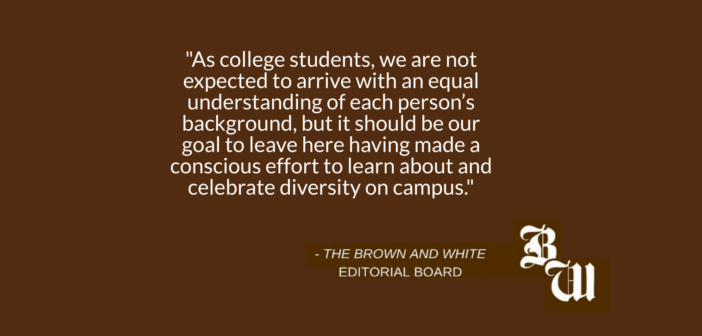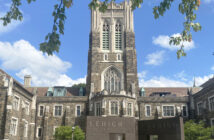Material appearing in editorials reflects the majority opinion of The Brown and White editorial board.
It’s time for students to see the writing on the wall.
“Lehigh University will not tolerate acts of prejudice, discrimination or property destruction directed at religious groups, just as we would not tolerate such acts based on race, gender, culture, immigration status or sexual orientation,” Donald Outing, the vice president for equity and community, said in a Sept. 11 email to the campus community after the Jewish Student Center was vandalized.
Just seven days later on Sept. 18, Lehigh was named a recipient of the 2019 Higher Education Excellence in Diversity Award by INSIGHT magazine.
And on that same day, President John Simon said in an email to the community, “We clearly have much work to do,” after the First-Generation house was vandalized “at some point over the past few weeks.”
While it is unclear at this point who exactly is responsible for the vandalism, it is clear that we can do better as a university.
Since the establishment of the Office of Diversity Inclusion and Equity in early 2017, the university has taken concrete steps to foster a diverse campus environment.
Offices such as the Center for Gender Equity, the Office of Multicultural Affairs and the Pride Center for Sexual Orientation and Gender Diversity are among the many resources offered to students.
When it was founded in 1865, Lehigh had an all-male, predominantly wealthy student body. It was not until 1956 that the first African American student graduated from Lehigh and 1970 that women were admitted.
While Lehigh’s diversity has fallen short in the past, it is exciting to see the community represent diverse financial, racial and personal identities.
But with the recent acts of ostracizing vandalism on campus, it is apparent that there is room for improvement.
According to the 2017 Lehigh Survey, students would like to see an expansion of education regarding diversity and inclusion, emphasizing peer-to-peer understanding and an acceptance of the range of student backgrounds.
The vandalism of the First-Generation house and Jewish Student Center do not reflect the efforts made by the campus community and contradict the values that students committed to when we began our four years at Lehigh.
When we commit to Lehigh, we commit to our community.
Communities—like the First-Generation house—offer spaces for students to celebrate their roots and share their experiences with others.
And while on-paper efforts by the university may grant us national recognition, our student body is responsible for the off-paper reality.
We are not all the same, and that is worth celebrating. Acts of hate on campus diminish the value of our college experience.
As college students, we are not expected to arrive with an equal understanding of each other’s backgrounds, but it should be our goal to leave here having made conscious efforts to learn about and celebrate diversity on campus.
Our four years at Lehigh are meant to propel us forward and prepare us to impact our communities. That impact starts here.
Homogeneity hinders the progress that diversity celebrates, and it insinuates that our university is moving backwards.
When we committed to Lehigh, we committed to each other.
As a student body, it is our duty to educate ourselves, ask questions and learn from those who come from different backgrounds than our own. If we can do that, then we can continue to move forward as a community.
Vandalism, exclusion and discrimination are not and will not be supported on our campus. We will not spend our four formative years moving backwards.
Instead, we will spend our four years pushing each other to expand our views of others beyond our own blinders.
From here, we will move forward. We will not forget the missteps that have occurred on our campus, but they cannot define our community. Change will begin once we choose to understand each other.






Comment policy
Comments posted to The Brown and White website are reviewed by a moderator before being approved. Incendiary speech or harassing language, including comments targeted at individuals, may be deemed unacceptable and not published. Spam and other soliciting will also be declined.
The Brown and White also reserves the right to not publish entirely anonymous comments.
7 Comments
Why does material in editorials have to reflect majority opinion of editorial board?
Hi J.M. Carven- Thank you for your question! The editorial board meets before each editorial is written to have a discussion that will be reflected in the piece. Therefore, the editorials reflect the majority opinion of that group of editors.
Is the first generation house a multicultural house of both white & non white males?
Assuming this means first generation college students of all races so therefore why is this a racial issue?
What is the motive or implication vs for example one frat egging another competitor frat which is simply kids being kids.
Ah, our PATRIOT2. Ever ready to make excuses for bigotry of all kinds. Ever unwilling to do the tiniest bit of reading to answer his own rhetorical questions.
Your question here was well-answered by about 1995, guy. Catch up. You went to Lehigh, you know how to look things up. Unless of course you just relied on frat files and cheating your way through.
If diversity did not exist, acting badly would still be wrong.
Let me put J.M. CARVEN’s question another way; why does The Brown and White not print minority view editorials?
This is SOP for newspaper editorial boards, Robert. Some work on a consensus basis; others go with majority, which is faster. Individual editors do sometimes write separate op-eds.
Thanks, this is a more informative reply to JMC. Being the student news organ of a university I would expect a variety of opinions in some instances